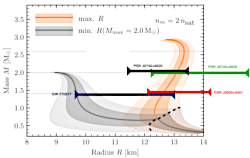 HEAPOW: Neutron Stars: Squishy or Stiff? (2021 May 10)
HEAPOW: Neutron Stars: Squishy or Stiff? (2021 May 10)
One of the principal outstanding problems in modern physics is the state of matter at densities at extreme densitiies exceeding that of an atomic nucleus. Theories range from normal nucleonic matter to exotic states impossible to reproduce in laboratories on earth. This extreme matter only exists in a stable form deep inside neutron stars, the burnt-out, collapsed centers of stars more massive than about 10 times the mass of the Sun. Constraining the properties matter in this weird state using observations of neutron stars is one of the key science goals of the Neutron Star Interior Composition Explorer, or NICER, mission on the International Space Station. Because the relationship between a neutron star's mass and radius is determined by the state of matter in its core, observations of the exteriors of neutron stars can constrain the properties of ultra-dense matter by determining the relation between a neutron star's size and its mass. Using sensitive measures of the variations of X-rays emitted by million-degree hot spots on the surface of rapidly spinning neutron stars called pulsars, NICER can precisely measure both the size and mass of the pulsar and thus constrain the state of matter in the hidden interior. In 2019, the first set of NICER neutron star mass-radius and dense matter constraints was published for the nearby millisecond pulsar PSR J0030+0451. Now a new measurement of the radius of a pulsar known as PSR J0740+6620 by NICER, announced by the NICER team at the April 2021 Meeting of the American Physical Society, provides the best constraints so far on the nature of the neutron star interior. PSR J0740+6620 has the highest neutron star mass known, over twice the mass of our Sun. Using extensive observations of PSR J0740 with NICER, augmented by X-ray imaging observations using ESA's XMM-Newton telescope, the NICER team derived a radius of PSR J0740 in excess of 11 kilometers (about the radius of the Washington DC beltway), as shown by the green and brown horizontal bars in the mass-radius plot above. This radius range is consistent with the radius range derived for PSR J0030, even though PSR 0740 is 30% more massive. For comparison, the radius range derived by the LIGO and Virgo gravitational wave observatories from observing the gravitational radiation produced by the neutron-star merger event GW 170817 is shown by the dark blue bar in the plot. The shaded areas show theoretical predictions for two different models of neutron star interiors, a "squishy" one in gray which results in smaller, higher-density neutron stars, and a "stiff" one, in which the high density matter is better able to withstand the crushing force of gravity, resulting in larger, less dense neutron stars. The NICER observations support the stiff model.
NICER: Determining the Stiffness of Neutron Stars
| << Previous HEAPOW | High Energy Astrophysics Picture of the Week | Next HEAPOW >> |